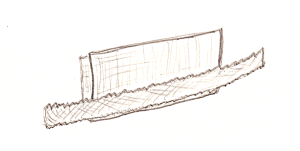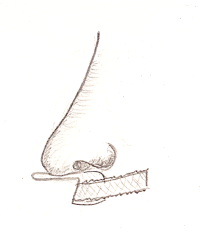I have been absent for the majority of the past three weeks due to various family medical issues. Everyone is OK now and I'm back to work. Part of the time I was out was because I had surgery, a septoplasty and turbinate reduction. Let me tell you about that surgery.
Oh, if you are squeamish you should stop reading now.
Really, just stop now.
You've been warned.
Septoplasty is surgery to go in and straighten out or repair the septum, the piece of cartilage that runs down the middle of the nose. It appears that early in my life my septum slid off to one side of the bone it's supposed to be resting on. I didn't think cartilage was afforded that kind of mobility, but apparently mine was. My doctor later explained with a disturbing amount of glee that the cartilage was "pretty messed up in there".
If I wasn't born with a deviated septum then it deviated when I was very young, as I've had some trouble breathing through my nose as long as I can remember, and had no idea what 'normal' breathing was like. I would frequently hear people with colds complain that they couldn't sleep because their nose was stuffed up and they could only breath through their mouth. I always found that kind of baffling as I never breathed through my nose while I slept, I simply didn't have enough air flow. Breathing through my nose as I slept was as plausible as breathing through my ears.
Anyway, as I've gotten older the situation has gotten worse and I finally decided to get it fixed, and two Mondays ago I went in for surgery. Now, I was told to expect one full week to recover and ..., well, let's look at what WebMD has to say:
After surgery, you may have a nasal splint or pack placed in your nostrils to stop bleeding and keep the septum straight while it heals.
The use of the term 'splint' doesn't really do them justice. Splint is such a small dainty word that I don't think it accurately reflects what happens. Here I've rewritten that description to better reflect reality:
After surgery, you may have canoe paddles shoved into your nostrils to stop bleeding and keep the septum straight while it heals.
You have no idea how deep your sinus cavity is. It is apparently deep enough that you can have four inch long pieces of plastic shoved into them well past the nostrils and then sown into place.
And left there.
For a week.
This, as you might imagine, is not comfortable. Not actually painful, mind you, but there is something about having canoe paddles touching the back of my sinus cavity, pressing up against the bottom of, oh, what should be there, let me remember, oh yeah, my brain, that rendered me completely incapable of rational thought. Yes, I was on Oxycodone for the first week, but even after I stopped taking them on Friday them I was still addled until the splints were removed the following Monday. During my recovery I received my copy of Slide:ology, among other books, but I read it first since it had the largest amount of white space and the prettiest pictures. Well, I tried to read it during my short wakeful periods. Occasionally I would stop and take a break and when I picked the book back up just for fun I would go back and read back a page from where I stopped. The last page I'd read, you'd think I'd remember it. Nope. It was all brand new. Now that I'm fully recovered I look forward to reading it again and actually retaining something this time.
Lynne was a great help and endured my being addled with aplomb. At one point we were having a conversation and it seemed vaguely familiar. "Have we had this conversation before?" "Several times," she responded.
Now, this is real surgery, and there is real blood involved, and one of things you need to do is have some gauze taped under your nose to catch the blood before it drips out onto your shirt. This is what I refer to as the 'nose diaper'. I've included a handy drawing of the proper way to prepare such a 'nose diaper' to help you, should you decide to have this surgery. This is probably different than what you will be shown at the hospital, as my nurse rolled up two or more sheets of gauze and taped the resulting thick ball wadding under my nose, which is both uncomfortable and almost completely ineffective for various hydrodynamic reasons I won't bother to explain.

The thoughtful reader at this point will note that there are two exits from the nose, the first out the front and the second down the back of your throat. There's no nose diaper you can construct for the flow of blood that exits that way. That explains the second prescription that I was given for the surgery: Promethazine, an anti-nausea medicine.
For the first week my wakeful time was really small, only about 4 hours a day, usually in one hour windows where I would get a drink, eat a very small meal, take another Oxycodone and maybe a Promethazine, change the nose diaper and then go back to sleep. Over the course of that first week I lost five pounds.

By the time I got to Thursday I was starting to feel a little better and tried to get up and move around the house some more, even going so far as to cook. This was a mistake, one for which I suffered four nose bleeds over the course of the evening, some of them involving a large amount of blood. I believe it was the third nose bleed when I was standing over the sink with blood running out my nose and out my mouth at the same time that I heard one of my family members remark, "Wow, that's more blood than on Fringe."
Based on all that blood on Thursday I went in for a checkup on Friday and one of the doctors 'cleaned out' my nose and the splints, which it turns out were hollow and I was supposed to be able to breath through them. He started off this process by taking two Q-Tips, dipping them into water or maybe hydrogen-peroxide and then shoving them down into the splints to 'loosen things up'. I will not lie, even with the Oxccodone and local anesthetic he gave me, that hurt. He then proceeded to use a suction nozzle to suck 'stuff' out of my nose. To be clear, blood tends to do that clotting thing and those clots have been hanging out in the newly renovated jungle-gym that was my nasal cavity for a week. I had a grim moment of pride when the small suction nozzle became clogged and the doctor had to switch to the large suction nozzle. That too became clogged but he was able to use it to drag out very large and colorful 'things', some of which were over a foot long.

The Monday following the surgery I went in to have the splints removed, which was a trememdous relief.
Remember the old coffee stirrers they used to have, the ones that look like two tiny straws glued together. When I was a kid we'd get those and try to use them as straws, and you had to work real hard to get any soda through them. Now imagine if someone switched out that straw while you weren't looking and you took another sip out of that now-normal sized straw. You'd suck too hard and a get a huge rush of soda in your mouth. That was exact thing I experienced repeatedly in the fifteen minutes after the splints were removed.
Breathe. "Whoa, Big Straw!"
Breathe. "Whoa, Big Straw!"
But after only 15 minutes I was breathing normally through my nose. And by normal I mean normal as in apparently most-humans-breathe-this-way normal.
After just one or two nights I was breathing through my nose when I slept, I expected it to take longer to unlearn forty years of habit.
My sense of smell is returning, but sporadically. Two weeks out from the surgery I can smell most things if I put them up close to my nose and it is improving a little every day. There are, however, weird periods where my sense of smell goes into overdrive and my nose picks out one thing to smell. For example, earlier this week I walked out into the back yard and was struck by the overwhelming smell of some charred wood in the chimenea 20 feet away. A minute or two later it passed and I could barely smell the charred wood when I put my head right up to the little fire place. I have had those super-smell moments two or three times a day after the splints were removed, sometimes to the most disgusting of odors, but they seem to be decreasing in frequency as my normal sense of smell returns.
All in all it was a totally miserable experience, but the end result is well worth it.
Sorry to hear about your ordeal Joe, but glad to hear the situation is improving and hopefully this will make a real positive difference over the course of your life!
Best wishes.
Posted by Bill Higgins on 2008-10-08
Posted by Dave Pawson on 2008-10-09
Posted by Paul Morriss on 2008-10-09
Posted by John Kemp on 2008-10-09
Posted by John Kemp on 2008-10-09
Posted by Michael R. Bernstein on 2008-10-09
Posted by Obama supportor on 2008-10-12
Wow, I had totally forgotten about the tooth pain, I would get random pin-pricks of pain across my teeth for a minute and then it would subside, but it went away after the first two days. Good luck with your recovery.
Posted by Joe Gregorio on 2008-10-12
 Joe Gregorio
Joe Gregorio
Posted by Luiz Rocha on 2008-10-08